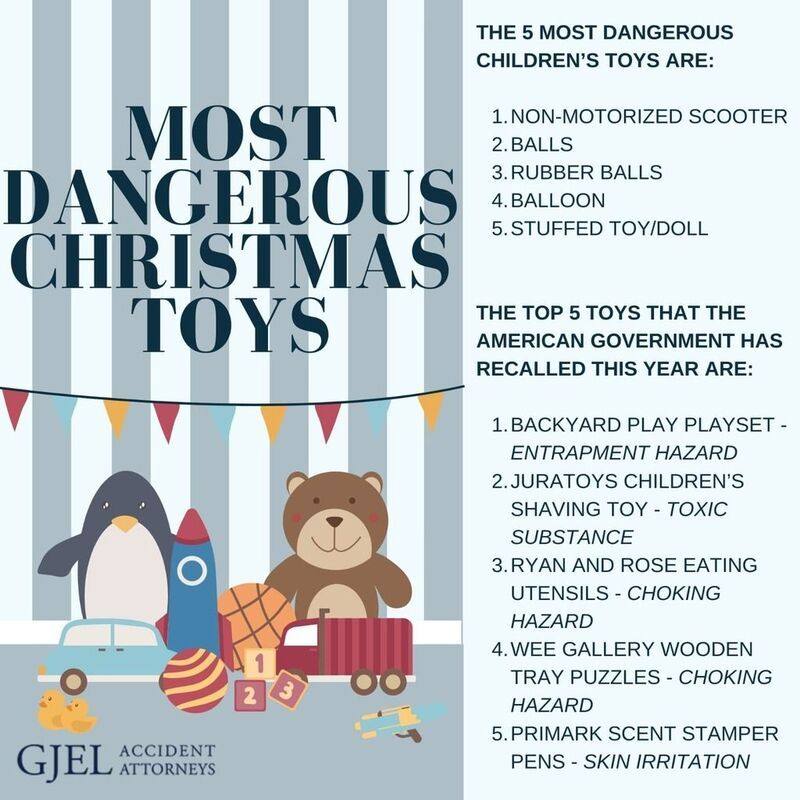Christmas is a magical time of year for millions of families across the United States, with children all over the country often experiencing new food, toys and traditions, often for the first time in their lives. It can also pose new risks to children though, and as they unwrap the presents underneath the Christmas tree, there are things we want to encourage parents to be wary of.
To do this we’ve decided to release a list of recalled toys ahead of the Christmas period, after non-motorized scooters were once again revealed as the most dangerous toy, responsible for 41,700 emergency department-treated injuries last year*.
Following the continued rise in electric scooters across the US, we’re also anticipating an increase in e-scooter related injuries this festive period; ER visits for e-scooter related injuries have increased by 507% since 2011 – a trend we expect to continue growing****.
Delving into which toys were the most dangerous for children, we found that non-motorised scooters were once again revealed as the most dangerous toy, responsible for 41,700 emergency department-treated injuries last year*. We have so far recovered more than $10 million for e-scooter accident victims.
Our research comes after the U.S. Consumer Product Safety Commission revealed data on the most dangerous children’s toys, based on child deaths and emergency department-treated injuries in 2020. An estimated 198,000 toy-related injuries were treated in U.S. hospital emergency in 2020, with boys accounting for 57% of the injuries*.
We found that balls and then rubber balls were the second and third most dangerous toys, according to government data from 2017** to 2020*. We also discovered that for every 100,000 children, 60 suffered a toy-related injury last year, a drop of 12% compared to 2019, with lacerations the most common toy-related injury children obtain, followed by contusions/abrasions and fractures*.
The 10 most dangerous children’s toys are:
- Non-motorized scooters
- Balls
- Rubber balls
- Balloon
- Stuffed toy/doll
- Toy chest
- Tricycle
- Inflatable water toy
- Toy dart
- Non-motorized riding toy

The top 10 toys that the American government has recalled this year are:
- Backyard play playset – entrapment hazard
- Juratoys Children’s Shaving Toy – toxic substance
- Ryan and Rose Eating Utensils – choking hazard
- Wee Gallery Wooden Tray Puzzles – choking hazard
- Primark Scent Stamper Pens – Skin irritation
- Hallmark teethers – choking hazard
- Zen Magnets and Neoballs Magnets – ingestion hazard
- Walgreens Disney Baby Winnie the Pooh Rattle Set – choking hazard
- Blue Star Trading Children’s Fishing Toy Game – lead poisoning hazard
- Battat Infant Teethers – choking hazard
While toy-related injuries and deaths have fallen by almost 20% since 2013*, our personal injury team is expecting an increase in electric scooter-related injuries, following the boom in popularity of the product, which is expected to surpass $33.5bn in market value by 2030***.
The estimated number of emergency department visits for e-scooter injuries has increased 507%, from 4,881 in 2014 to 29,628 in 2019****.
To help parents and guardians combat toy-related injuries this year, we’ve collated a guide from expert sources on how to avoid common toy-related injuries this Christmas:
- *****Read the labels before buying any toy. The label should tell you to what ages the toy is safe for, how to use it, whether adult supervision is recommended for assembly or use. You also want to make sure toxins or chemicals like lead have not been used in making the toy.
- Think big when it comes to buying a toy: any toy should be bigger than your child’s mouth to prevent choking. Double-check labels to make sure there are no small parts that can be choking hazards. Older children should put their toys with small parts away so smaller children cannot find them for just the same reason.
- Avoid toys that shoot small objects into the air to avoid choking or eye injuries (they do occur). Avoid toys that make loud or shrill noises that can potentially damage hearing. Make sure batteries in battery-powered toys are secured so small children can’t get them open and choke or swallow them, which would be a medical emergency.
- Make sure a toy is sturdy. For example, the parts of a stuffed animal should be sewn on securely and that same stuffed animal should be washable and made with flame-resistant or flame-retardant materials.
- Crib toys should not have strings or wires longer than seven inches: so an infant cannot get caught on or around the wires and accidentally strangle themselves.
******Back blows for babies under 1 year:
- Sit down and lay your baby face down along your thighs, supporting their head with your hand.
- Give up to 5 sharp back blows with the heel of 1 hand in the middle of the back between the shoulder blades.
Back blows for children over 1 year:
- Lay a small child face down on your lap as you would a baby.
- If this isn’t possible, support your child in a forward-leaning position and give 5 back blows from behind.
- If back blows don’t relieve the choking and your baby or child is still conscious, give chest thrusts to infants under 1 year or abdominal thrusts to children over 1 year.
This will create an artificial cough, increasing pressure in the chest and helping to dislodge the object.
Chest thrusts for children under 1 year:
- Lay your baby face up along the length of your thighs.
- Find the breastbone and place 2 fingers in the middle.
- Give 5 sharp chest thrusts (pushes), compressing the chest by about a third.
Abdominal thrusts for children over 1 year:
- Stand or kneel behind your child. Place your arms under the child’s arms and around their upper abdomen.
- Clench your fist and place it between the navel and ribs.
- Grasp this hand with your other hand and pull sharply inwards and upwards.
- Repeat up to 5 times.
Make sure you don’t apply pressure to the lower ribcage, as this may cause damage.
*******What to do if a child has a head injury:
Call your healthcare provider right away if your child had a head injury and:
- Is an infant
- Has lost consciousness, even for a moment
- Has any of these symptoms; won’t stop crying, complains of head and neck pain (younger children who aren’t talking yet may be more fussy), vomits more than one time, won’t awaken easily, becomes hard to comfort, isn’t walking or talking normally.
If your child is not an infant, has not lost consciousness, and is alert and behaving normally after the fall or blow:
Put an ice pack or instant cold pack on the injured area for 20 minutes every 3–4 hours. If you use ice, always wrap it in a washcloth or sock. Ice placed right on bare skin can injure it.
Watch your child carefully for the next 24 hours. If the injury happens close to bedtime or naptime and your child falls asleep soon afterward, check in a few times while they sleep.
If your child’s skin color and breathing are normal, and you don’t sense a problem, let your child sleep unless the doctor tells you otherwise. There’s no need to keep a child awake after a head injury.
Trust your instincts. If you think your child doesn’t look or seem right, partly awaken your child by sitting them up. They should fuss a bit and attempt to resettle. If your child still seems very drowsy, try to awaken them fully. If you can’t wake your child, call your healthcare provider or 911 for an ambulance.
What to do if a child is unconscious following a head injury?
- Don’t move the child in case there is a neck or spine injury.
- Call for help. If you have a phone with you, call 911.
- If the child is vomiting or having a seizure, turn them onto their side while trying to keep the head and neck straight. This will help prevent choking and protect the neck and spine.
Andy Gillin, managing partner of GJEL, said,
“As we know Christmas is one of the most magical times of year, however the festive season can also offer lots of potential hazards, with new toys, foods and products often being introduced into a child’s life for the first time.
“With children accidents do happen, but parents can reduce the chance of toy-related injuries by doing their research and of course always keeping a watchful eye on their little ones. I hope our study into the topic has helped shed some light on the toy market, and offers insight on what might not make a suitable or safe Christmas gift this year.”
The most dangerous toy list is based on the number of children who died as a result of playing with a toy in 2020*.
Sources:
*https://cpsc-d8-media-prod.s3.amazonaws.com/s3fs-public/Toy-Related-Deaths-and-Injuries-2020.pdf
**https://www.cpsc.gov/s3fs-public/Toy-Related-Deaths-and-Injuries-2019.pdf
****https://jamanetwork.com/journals/jamanetworkopen/fullarticle/2770043
*****https://medcenterblog.uvmhealth.org/children-health/the-best-holiday-gift-is-a-safe-toy/
******https://www.nhs.uk/conditions/baby/first-aid-and-safety/first-aid/how-to-stop-a-child-from-choking/



 AI-search
AI-search  Email
Email